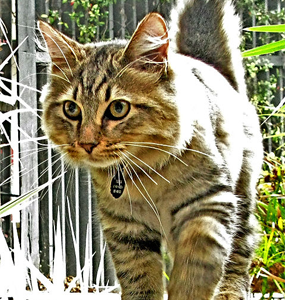Background:
This curious cat is a leaf on the domestic feline’s family tree. The American bobtail got his name from his unusually stubby, “bobbed” tail: which was the result of a genetic mutation that affects tail growth.
One of the earliest stories about the American bobtail was recorded in the 1960’s when a young couple found a brown, male, tabby kitten with a bobbed tail on a Native American reservation in southern Arizona. It was rumored the kitten was the offspring of a wild bobcat and a domestic farm cat. The couple kept the bobtail and bred him with a domestic long-tailed female. Some of the kittens in the litter were also born with bobbed tails.
Cat Facts:
- This breed is extremely stocky.

- The bobtail can be born with either shorthair or longhair, and is generally shaggy but rarely fluffy.
- The bobtail’s eyes are almond shaped and can come in any color.
- The bobtail’s coat color is available in a broad spectrum.
What’s the American bobtail like?
American bobtails take about two to three years to fully mature. Being a very sturdy cat, their hips are almost as wide as their chest. The bobtail’s hind legs are a little longer than their front legs and they have large round paws.
Bobtails have dog-like personalities. This breed is very playful and energetic and loves to play fetch and learn new tricks.
American bobtails are a reportedly healthy breed with no particular stand out health problems. They are a very hearty breed, which is due to the density of feral bloodlines in their pedigree.
Takeaway points:
- American Bobtails are extremely tolerant and can endure being picked up and aggressively played with.
- This breed is known for being a great traveler and they make great pets for long-haul truck drivers. They have also been very therapeutic for people with anxiety because they’re well behaved and sensitive.
- With his dog like behavior, comes a clown-like behavior. The bobtail will entertain you for hours by playing games like fetch or hide-and-go-seek.
If you have any questions or concerns, you should always visit or call your veterinarian – they are your best resource to ensure the health and well-being of your pets.
